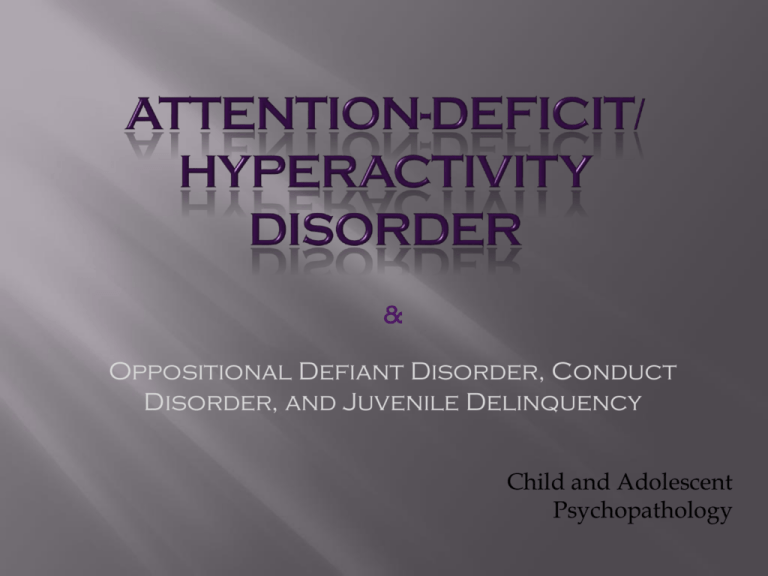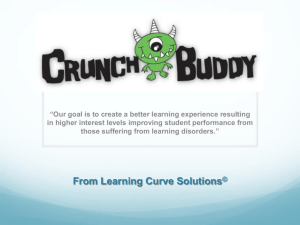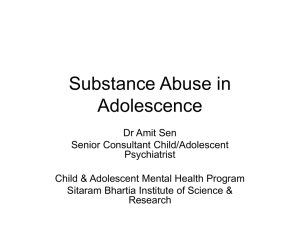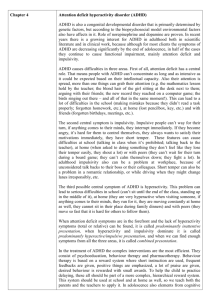Attention-Deficit Hyperactivity Disorder
advertisement

& Oppositional Defiant Disorder, Conduct Disorder, and Juvenile Delinquency Child and Adolescent Psychopathology 1) Inattentive-disorganized (314.00) 2) Hyperactive-impulsive (314.01) 3) Combined type (314.01) Controversy over whether impulsivity should belong to hyperactive-impulsive type or separate category Careful history Data from multiple informants (e.g., parents, teachers) Not normal developmental variation (e.g., toddlerhood) Rule-out diagnoses (e.g., anxiety and mood disorders, sleep and health-related disorders, some learning disorders) Direct observations Functional impairments (e.g., at home and school, with peers) In U.S. population: 6.8% between ages 6-11 (although half also received diagnosis of LD) 4.4% of adults diagnosed 5.3% of worldwide prevalence estimate *Percent of Youth 4-17 ever diagnosed with AttentionDeficit/Hyperactivity Disorder: National Survey of Children's Health, 2003 ① Genetic influences on liability to ADHD: Heritability estimated between .6 and .9 Nonshared environmental effects are modest to small Shared environmental effects are negligible Genome-wide scans: focus on chromosome 5 (where DA transporter gene has been mapped) Candidate gene studies: DA receptor genes (e.g. DA beta-hydroxylase gene) ② Environmental Risks and Triggers a) Gene-environment correlations: Parents who pass on ADHD genes and also provide chaotic home environment Child contributes to counterproductive socialization experiences Caregiver behavior also impacts ADHD sx Transactional model: but child effects are greater (e.g., medication reduced mothers' negative/controlling behaviors) b) Gene-environment interactions Inflated heritability term in twin studies: experiential effects might differentially activate genetic risk Unknown effect size of these experiential effects c) Environmental risk factors: Low birth weight (<2,500 grams) Prenatal teratogens: o o Maternal alcohol exposure Maternal smoking Postnatal exposure to toxins (e.g., lead exposure) Dietary insufficiencies (Uganda experience) 5% reduction in overall brain volume 12% reduction in volume of key frontal and subcortical structures *UQ neuroscientist, Dr Ross Cunnington of Queensland Brain Institute (QBI) said there appears to be a biological difference in the brain that makes some children more susceptible to attention deficit hyperactivity disorder, combined type (ADHD-CT) (2007) *Neuroanatomical and functional model of attention-deficit hyperactivity disorder developed by Arnsten et al. (1996). Lateral view of the brain with a section of the cortex removed. Red lines represent noradrenergic pathways and black lines indicate cortical pathways mediated primarily by excitatory amino acids. Attention: ability to filter information is compromised ② Cognitive control: strategic allocation of attention and response is compromised ① a) Working memory: Limited capacity system for keep something in mind while doing something else is compromised, especially spatial working memory weaknesses b) Response suppression: Ability to interrupt a response during dynamic moment-to-moment behavior (e.g. checkswing) is compromised c) Set shifting: shifting one’s mental focus within a task is compromised (e.g. sorting by color or number) *Wisconsin Card Sorting task d) Task switching: alternating tasks is compromised (e.g. counting or naming objects) ③ Motivation, approach, and reinforcement response a) ADHD not related to low reactive control as in psychopathy b) ADHD related to weakened reinforcement delay gradient - lose interest in reward earlier than others c) Positive response to high intensity reinforcement d) Lack of physiological response to potential rewards ④ Temporal informational processing and motor control a) Faulty time perception for behavioral control b) Poor time estimation c) Poor time reproduction Diagnosis as young as age 3 Motoric hyperactivity more pronounced in preschool Inattention more pronounced with age Criteria for adolescents and adults are lacking Sex differences: Male preponderance: 2.5:1 in childhood, 1.6:1 in adulthood Girls are less likely to show comorbid externalizing problems Some impaired girls are missed by current diagnostic criteria Girls might have greater resistance to etiological factors of ADHD ADHD informant ratings differ cross-culturally ADHD might consist of different systems cross-culturally Differences in treatment crossculturally (stimulants for minorities) Birth weight × lack of parental warmth ADHD (moderational model) Effectiveness in neuropsychological response inhibition Protective factors for ADHD children: reading ability absence of aggressive behavior positive peer relations effective parenting Specification of heterogeneity of ADHD Specification of etiologies of ADHD subgroups Specification of key moderators of ADHD behaviors Specification of long-term treatment Juvenile delinquency: Children who have broken a law Conduct Disorder: 3 out of 15 antisocial behaviors within 12 months Oppositional Defiant Disorder: 4 out of 9 disruptive interpersonal behaviors ODD, CD, ADHD all co-occur ODD and CD cooccur with depression ① Childhood-onset (life-course persistent) trajectory: (5-14%) • • Early neurodevelopmental deficits Inadequate parenting and adverse social influences ② Adolescent-onset (adolescence-limited) trajectory: (10-21%) • Few conduct problems in childhood First law breaking in adolescence Desist from offending in early adulthood • • ③ 3:1 Ratio of males to females for childhood onset, but 1:1 ratio for adolescent onset ④ Not two distinct trajectories but rather a continuum for children ⑤ CD children mostly childhood onset and met criteria of ODD ① ODD more prevalent than CD during early childhood ② ODD and CD have equal prevalence through adolescence ③ CD increase is greater in males than females ④ ODD more prevalent in males at all ages ⑤ Rates of delinquency peak at 16 or 17 and then decline sharply (age-crime curve) ① Temperament: resists control, responds to threats with negative emotions, daring sensation-seeking, low prosocial behaviors, impulsivity, lack of persistence ② ODD CD ③ ADHD × CD APD (moderational model) ④ Early shyness and anxiety conduct problems Childhood cognitive skills and language conduct problems ⑥ Lower verbal intelligence conduct problems because affect more likely to be expressed behaviorally, more frustrating for parents Likelihood of other serious mental Dx in adulthood ② Majority of CD children (60-70%) do not progress to ④ ⑤ ⑥ APD Likelihood of depression (CD stressful life events depression) (mediational model) Adolescent suicide with CD, depression, and substance abuse Adult males: criminal behavior, work problems, substance abuse Adult females: depression, suicidal behavior, poor physical health Birth weight and birth complications Maternal cigarette smoking and substance use during pregnancy SES + lower parental education (mostly childhood onset) Parental characteristics, family characteristics, and parenting Parental antisocial behavior and substance abuse Low maternal IQ Young mothers Mother’s multiple partners and discordant relationships Deviant peer influence and gang membership • • Almost all adolescent crime is committed with peers Association with delinquent peers is highly correlated with delinquency Neighborhood and urbanicity: poverty and social disorganization Maltreatment × low-activity MAO-A genotype Conduct problems Birth weight × high-risk COMT genotype Conduct problems Prosociality vs. callousness During sensation-seeking vs. fearful inhibition Negative emotionality vs. emotional stability Slowly developing cognitive skills and language (interferes with socialization experiences) Fin







